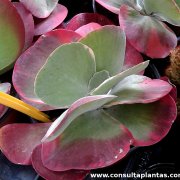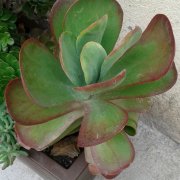Care of the succulent plant Kalanchoe thyrsiflora or Paddle plant |
|
The genus Kalanchoe, family Crassulaceae, comprises 100 species of succulent plants native to Asia, Africa and Europe. Some species are: Kalanchoe thyrsiflora, Kalanchoe pumila, Kalanchoe marmorata, Kalanchoe longiflora, Kalanchoe daigremontiana, Kalanchoe beharensis, Kalanchoe tomentosa, Kalanchoe gastonis-bonnieri, Kalanchoe blossfeldiana, Kalanchoe uniflora, Kalanchoe manginii, Kalanchoe pinnata, Kalanchoe fedtschenkoi. Common names: Desert cabbage, Paddle plant, Flapjacks, White lady, Meelplakkie. This species is native to southern Africa. They are succulent plants with rosette leaves, fleshy, flat, round, covered with white wax and grayish-green in color with reddish edges that reach 1 meter (3.28 feet) in height when they bloom. The flowers appear in terminal inflorescences, they are tubular and green and yellow. They can bloom from mid-winter to late spring. The plant dies after flowering. Paddle plant is used in rockeries, in dry areas of the garden, in flowerbeds and borders and in pots for terraces and balconies. It combines well with Cotyledon orbiculata and Crassula arborescens. Kalanchoe thyrsiflora needs full sun or semi-shade exposure; in Mediterranean climates it prefers light shade. Desert cabbage can grow in any well-drained soil. In pot use a commercial substrate for cacti and succulents. Water moderately waiting for the substrate to dry; in winter water only once a month. It's very important not to water too much. Fertilize monthly in spring and summer with mineral fertilizer for cacti and succulents. Paddle plant does not need pruning. Kalanchoe thyrsiflora is sensitive to fungal attack if the humidity is excessive. White lady propagates from leaf cuttings (it's important that they have a piece of stem); root in a slightly damp sandy substrate. |
Images of the succulent plant Kalanchoe thyrsiflora or Paddle plant |
Find plants
Kalanchoe thyrsiflora or Paddle plant | Care and Growing
© 2026 FavThemes







